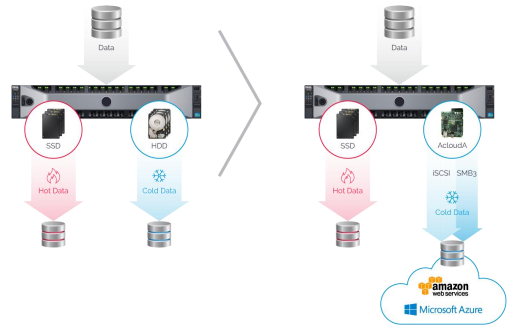StarWind Storage Appliance and AcloudA Use Case
- September 19, 2016
- 5 min read

INTRODUCTION
Flash technology is gradually dropping in price and has almost reached the same figures as expensive hard disks. However, when it comes to storing large amounts of data, hard disk drives are still cheaper in the long run and thus are widely utilized. Besides, by tiering “hot” and “cold” data between SSD and HDD, it’s possible to enjoy the benefits of both, without dealing with all the drawbacks at the same time. Thus, hybrid storages are becoming more and more popular, because they offer performance for “hot” data and capacity for “cold” data, while they cost less than all-flash setups.
PROBLEM
Hard disks have one principle unavoidable flaw – any mechanical part with break in time and a serious malfunction can cause major data loss. The more HDD are utilized and the more data is stored – the higher the chance of failure. This means, that there is much planned and unplanned maintenance required, resulting in more expenses. For companies that require extensive storage setups for primary data and backups, both CapEx and OpEx will go through the roof. It is also hard to predict data growth and the needed capacity, so every storage setup must include extra disks, which means even more money spent. When it comes to using cloud services it is easy to meet capacity requirements precisely by purchasing the exact amount of cloud storage. Ideally, a company should follow the 3-2-1 backup plan, which states that there must be 3 copies of data in 2 formats and one should be on a remote location. The latter may be achieved with cloud services, but specialized hardware and software is required for that. Again, it all comes to higher capital and operational expenses.
SOLUTION
Utilizing a storage platform with built-in cloud gateway, it’s easy to add public cloud as an extra storage tier without any other expenses. StarWind Storage uses AcloudA – an HDD-like device, which fits into a standard hard disk slot and is functionally a turnkey cloud gateway. It utilizes iSCSI and SMB3 protocols, so it can automatically connect to popular cloud services, like Azure, Amazon or Iron Mountain. All hard disks can be replaced by one AcloudA device, so all the “cold” data goes to cloud, while “hot” data and cache stay on internal SSD of StarWind Storage Appliance. Also, some HDD may be left in order to have an additional on-site tier for the most recent “cold” data. This way, the company can follow the 3-2-1 backup rule without breaking the bank. The process is elementary: AcloudA attaches to StarWind Storage Appliance instead of a SAS or SATA HDD, automatically enabling cloud gateway. All that’s left is purchasing space in public cloud and the reliable storage solution is ready.
AcloudA replaces an HDD and sends all cold data to cloud
AcloudA has a whole new approach to data security, so simple and efficient, that it literally leaves 0% chance of any intrusion. While it’s technically possible to trace the data from cloud back to AcloudA, that’s just about it. As long, as the data is encrypted and the keys are held in the primary infrastructure, there is no way for anyone to get their hands on the keys or intercept any real data. The reason is simple – even if the hacker gets full control of the device itself, there is physically no way to go any further.
СONCLUSION
StarWind Storage Appliance with AcloudA offers an easy way to follow the “3-2-1” backup rule adding public cloud like Azure, Amazon or Iron Mountain as a secure storage tier. AcloudA attaches to StarWind SA, replacing an HDD, and functions as an unbreakable cloud gateway, meaning it won’t let any external force in under any circumstances.


